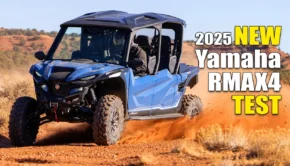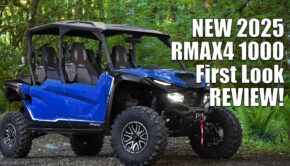Published on June 17th, 2025 | by Joe
Updated 2025 Yamaha RMAX2 Test Review
2025 Yamaha RMAX2 1000 Test Ratings
Summary: Yamaha has certainly made the best-in-class RMAX 1000 even better. No shootout needed; the 2025 Yamaha RMAX 1000 has simply widened the gap between itself and the competition.
4.7
1 Day Test
The best 1000cc Sport Utility gets even better!
The Yamaha RMAX 1000 was enthusiastically received by many in the SXS community when it was introduced back in 2021. It certainly left a great impression on our test drivers as it went on to win our 2022 1000cc Sport Utility SXS Shootout against the Polaris General and Can-Am Commander. For 2025, Yamaha has made a number of improvements to the RMAX to enhance its suspension and handling, drivetrain performance, utility capability, and functionality of their all-new Adventure Pro infotainment system.
A few months back we had the chance to experience these upgrades in Yamaha’s new 2025 RMAX4, full-size, four-seat SXS. We were impressed with Yamaha’s new sew stretch version of the RMAX4, but how did the new updates and features carry over to the reigning and defending class champion RMAX2? Yamaha invited us to the highly technical and challenging trails of the Box Canyon OHV area near Florence, Arizona to find out.
UTV on Demand’s test of the 2025 Yamaha’s updated 2025 RMAX2 1000 was made possible by…
Cardo
Trim Packages
The 2025 RMAX2 1000 is available in four trim packages starting with the entry level priced R-Spec. It benefits from all the 2025 updates minus the new EPS being 3-mode selectable. If you aren’t into the latest electronic upgrades like Adventure pro and want to accessorize your own machine, it’s a good value at $21,799.
The more sport focused RMAX Sport adds new 3-mode power steering, beadlock wheels, and trades the R-Spec’s GBC Dirt Commander 2.0 tires for more sport focused GBC Terra Master Tires mounted on beadlock wheels. Fox QS3 shocks are swapped out for Fox Podium 2.0 shocks with preload, high and low-speed compression, and rebound damping adjustments. Other features include 3 throttle modes, interior LED lighting, backlit switches and knobs, plus a rear view mirror. It’s a sportier sport/utility at $23,699.
From there, the rugged adventure focused XT-R edition and more luxury focused Limited Edition add Yamaha’s brand new Adventure Pro infotainment system with a new MTX audio system specific to each model. Selectable power-steering, drive modes, Warn VRX45 winch, and Maxxis Carnivore tires are found on both. The adventure focused XT-R mounts them on beadlock wheels. They both use 3-way compression adjustable shocks with Fox QS3s used on the XT-R and IQS shocks used on the limited. IQS shocks allow you to swap between their soft, medium, and firm settings from inside the cockpit with the flip of a switch. The LE model also features a backup camera installed from the factory. All other Adventure Pro equipped models come prewired for easy camera installation. The LE model also comes with a full color TFT display.
Retail for the XT-R is $24,999. The LE retails for 25,499.
Interior and styling
Styling remains unchanged for 2025 with new colorways on some trim packages. LED lighting is found at both ends. Doors feel solid with handles mounted on the inside to keep them cleaner. Getting in and out is relatively easy aside from leaning forward a bit to clear the shoulder bolsters.
The interior remains at the front of the class with a nearly automotive quality design and good comfort. There’s plenty of space for most occupants that’s configurable. There’s a slide adjustable passenger grab handle. The driver’s seat is slider adjustable. The soft-touch steering wheel offers 17° of tilt adjustment. Seatbelts are height adjustable. Soft touch points are found on the doors and center console for both occupants’ enhancing comfort.
All of the RMAX controls feel solid and refined. There’s seemingly no rattles or squeaks from the doors, seats, or any part of the machine. The seats feel a bit upright for the machine’s performance and, perhaps, a bit more bolstering on the front of the seat base would be nice on steep downhills, but they’re otherwise comfortable. Upright seating plus the hood and front fender design offer an excellent sightline out of the car, but they make you a little more susceptible to flying mud in those conditions. The gas pedal’s shape can make initial pedal movement modulation a little challenging for some, but Yamaha D-mode switch with various throttle modes helps negate that issue.
RMAX allows easy accessory integration. Numerous cutouts with easily removable rubber covers allow for easy accessory switch installation. Interior storage includes a 5.8L passenger glove box and 2.7L center console plus 2 cup holders. The center console features a pass through in the rubber seal for phone charging.
All RMAX2 models come with sun tops standard featuring integration with Yamaha’s accessory windshield, cab enclosure system.
The LE model’s full color TFT display is mounted on the steering column, moving up and down with the steering wheel like the LED display on the others. Linked to the TFT display and displaying the view from the rear facing camera on LE models, Yamaha’s Adventure Pro GPS infotainment system is all new for 2025. It’s now built into the dash and features a ton of updates and improvements. The 7” screen is brighter with greater contrast. With control of the new MTX audio system integrated into it, there’s no longer a need for a separate head unit. Navigation has been completely updated along with geofencing and driver notification. A new drive mode screen features pitch and tilt gauges. The info displayed is very customizable and Adventure Pro can connect with your phone via Bluetooth for displaying messages or playing music. We wish it included the Sport model as it’s the trim best suited for covering lots of miles at higher speeds.
Engine Performance
As the fastest accelerating powerplant with the broadest, strongest power curve, the class leading 108HP engine produces 8hp more than the competition. Yamaha’s proven 999cc, liquid cooled, parallel twin-cylinder engine features a four-valve, DOHC head design with a very sporty 11.2:1 compression ratio.
Air for the engine and transmission are drawn from high under the hood. There you’ll find the airbox providing tool-less access to the engine’s primary foam and secondary paper filter. Fuel-injection delivers the air and fuel via dual 48mm throttle bodies with fuel drawn from the RMAX4’S 9.2gal fuel tank.
Drive by wire throttle offers three modes: crawl, trail, and sport. They retard or advance throttle delivery providing different power characteristics. All modes deliver full power at full throttle. Crawl and trail modes provide maximum engine braking with reduced engine braking in sport mode. Engine braking is delivered to two, three, or four wheels depending on the drive train mode you’re in.
Yamaha’s Ultramatic CVT transmission has a 10-year belt warranty thanks to its primary wet clutch handling engagement and disengagement, allowing the belt to stay under constant tension, reducing wear. A one way bearing in the clutch provides engine braking at all RPMs.
The engine makes power across the RPM range with strong low-end torque. Midrange and top power class leading, especially beneficial when the trail opens up.
Power is very manageable at all speeds. The CVT’s primary clutch delivers controllable automotive-like acceleration off idle. While we still don’t love the gas pedal shape, Crawl and Trail modes make pedal modulation a non-issue. Spending most of the day in sport mode to maximize power feel, the CVT proved very responsive when getting in and out of the gas, always keeping you in the best part of the power.
Engine braking is well matched with the different throttle modes. It helps keep speeds under control on descents in Trail and Crawl modes. Sport mode’s reduced engine braking is beneficial when coasting through chop or braking bumps.
The drivetrain was updated on all RMAX models for 2025 with stronger differentials and new features. RMAX continues to offer 2WD, limited slip 4WD, and 4WD with front differential lock. A new front differential was utilized to provide quicker engagement and disengagement allowing you to switch to front differential lock at speed, with it engaging at lower speeds. The ignition no longer cuts power during engagement.
One thing that held the RMAX back in utility ratings in our 2022 shootout was a lack of turf mode, allowing you to unlock the rear differential, preventing damage to manicured surfaces. Yamaha added it for 2025.
Drivetrain upgrades performed as advertised. 2WD is fun for drifting. 4WD provides the most accurate steering while providing extra grip for obstacles or slippery conditions. Front diff lock engagement and disengagement are now dramatically quicker, so Kory was happier using it more often. Turf mode was a feature RMAX needed, and we’re glad Yamaha is paying attention as its desirability as a work vehicle has been enhanced.
Suspension and Handling
The RMAX is built on a steel frame protected underneath by a welded-on, steel skid plate with a front plastic skid plate and rear CV guards. Kickouts on the lower frame rails help prevent snagging a rear wheel on trees or other obstacles. Winch-ready steel bumpers feature very overbuilt looking tie down hooks for easy trailering.
The RMAX2 utilizes dual A-Arms front with wide-arc lower arms for improved ground clearance. Dual control arms out back utilize stamped steel lower arms for improved strength. We remain impressed with the stout appearance of the exposed frame and suspension parts.
Fox Podium 2.0 QS3 shocks are used on the R-Spec and XT-R models with Fox IQS shocks found on the LE model. Both shocks feature nitrogen reservoirs, dual rate springs with preload adjustment, and three-way compression damping adjustability with soft, medium, and firm settings. Compression adjustment is found on the reservoirs on the QS3s, while the IQS system allows you to select compression damping settings via a switch inside the cockpit. RMAX Sport is outfitted with essentially race suspension, Fox RC2 shocks delivering preload, high and low-speed compression and rebound damping adjustments.
The RMAX2 features class-leading suspension travel at both ends with 14.2” front and 16.9” rear. That’s nearly 3” more rear suspension travel than General XP 1000, within 1/10” of an inch of Yamaha’s YXZ1000R sport SXS, and more overall travel than the 64” wide Honda Talon X sport model. Equipped with a sway bar up front, it forgoes a rear sway bar for maximum articulation in uneven terrain.
While the RMAX was the king of rock crawling, its ride was a little firmer than the competition over small bumps. On mildly whooped out terrain, the rear end could pack up and deflect a bit if you didn’t keep speed in check. For 2025, Yamaha reworked the shock tune on all but the Sport model, in search of increased small bump compliance, improved ground contact, and reduced harshness when bottoming.
Already arguably the best in the business, Yamaha introduced an all-new power steering system across the RMAX line for 2025. Selected by a switch on the dash, it now offers three modes: high, standard, and low assist. Power has been increased from 40A to 60A. This results in a 62% increase in electrical power and a 121% increase in available torque assist, automatically offering maximum assist with the front differential engaged.
A 64” width is in line with the class. The RMAX2’s 86.7” wheelbase is somewhere between the Polaris General and Can-Am Commander.. Rolling on 30X10-14” tires mounted on 14” aluminum wheels, the RMAX2 delivers the square wheel tire setup we prefer. Ground clearance is class leading at 13.8”.
The updated shocks are notably more sensitive to small bumps in the trail at all speeds. Bottoming resistance on large, abrupt, square edge hits or drops was decent, but has been noticeably improved. On abrupt G outs and rollers, the rear shocks do a little better at staying off the bottom out bumper, deflecting less on rebound. This results in a marginally calmer back in rollers. It may not quite have the high speed prowess in whoops as the General, but the shocks are clearly improved all-around without a noticeable loss in articulation and ride quality in technical terrain.
The highly adjustable Sport model’s Fox RC2 shocks are still a little more capable everywhere. They can be tuned to be a bit plusher on small bumps and chatter. They’re also capable of performing notably better in whoops and abrupt G-outs. If staying on the gas is your thing, the sport can be better suited for it if you’re willing to take the time to dial in the very adjustable shocks.
The 3-mode EPS system did everything we hoped. Low assist added stability at high speeds by making the steering wheel less sensitive to unwanted inputs. High assist was advantageous on tight, twisty trails and technical crawling situations. Steering with the front differential locked in is like magic, remaining nearly as light as steering in 2WD. The middle setting delivered power steering performance similar to what we’re accustomed to on RMAX models, which is perfect for all-around driving, relatively light with great damping of unwanted steering feedback.
Kory felt the Maxxis Carnivore tires pushed in sandy conditions. The GBC Dirt Commander 2.0 equipped R-Spec, and, especially, the GBC Terramaster tire equipped Sport models delivered the precise steering accuracy we’ve come to expect from the RMAX. If you’re not driving in sand, chances are you’ll be happy with the Maxxis Carnivore tires.
Cornering and side-hill stability are very good. The front end feels rock solid in turns with a little rear-end body roll attacking corners hard. It’s like a trophy truck in that way and didn’t compromise confidence drifting or cornering hooked up.
Brakes
In 2021, we applauded the RMAX2’s braking power, but felt the pedal took a little more pressure than we expected. The RMAX line gets updated brakes for 2025. Hayes calipers and knuckles are more rigid. Yamaha’s goal was increased initial bite and a more solid feel through the pedal.
Braking power was at least on par with previous models. As advertised, engagement felt more solid through the pedal requiring less pedal pressure and movement.
Work Capability
In addition to its abundant interior storage, the RMAX features the hydraulically assisted dumping cargo bed. Steel tie-down hooks are found on the bottom. Slots in the sides allow for easy partitioning, and it can carry up to 600lbs. Our only critique is that the rear hinge placement and level of assist leaves you wanting a friend when dumping a 600lb load. The two-inch hitch receiver can tow up to a full ton. With the addition of turf mode, RMAX could now be a threat for best in class utility performance.
Conclusion
The RMAX 1000 is still the king crawling through technical terrain, now delivering improved comfort and capability at all speeds. The upgrades in front differential engagement speed and the new EPS’s lighter steering with the front differential locked encourages you to take advantage of diff-lock more often. The unlockable rear differential is a huge improvement for those wanting a sport utility SXS they can work with. The brakes offer improved power and feel. The new Adventure Pro is undeniably better.
Yamaha has certainly made the best-in-class RMAX 1000 even better. No shootout needed; the 2025 Yamaha RMAX 1000 has simply widened the gap between itself and the competition.









